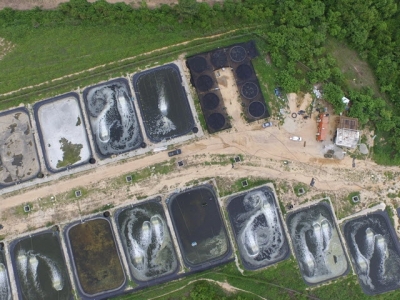What is a biofloc System?

Biofloc aquaculture is a recirculating, highly aerated, closed-loop pond system that produces high volumes of shrimp while using fewer resources than conventional farming.
It relies on creating a complex probiotic environment that both nourishes the shrimp while decreasing any negative impacts. Among the benefits of biofloc farming are better water management, reduced dependency on fishmeal (feeds), and greater biosecurity.
How it works...
In a biofloc system, the water is inoculated with many strains of bacteria, microorganisms such as zooplankton, and protozoa as well as algae that form groups called ‘flocs.’ These ‘flocs’ take advantage of the high concentration of shrimp, and the resulting organic matter, by dissolving the nitrogen from the shrimp waste and converting it to microbial protein. The shrimp then eat the flocs. It is a circular system, where the microorganisms benefit from the shrimp waste, and the shrimp benefit from the microorganisms.
A biofloc farming system should be considered a dynamic living organism, and should be managed as such. Just as you would when making lacto-fermented vegetables in the kitchen, the farmers are cultivating a beneficial bacterial load so the shrimp can thrive.
Naturally protects from diseases
We’ve heard a lot lately about the benefits of probiotics for human health. They are beneficial for shrimp too. The probiotic nature of the pond protects the shrimp population from common diseases that can plague conventional farms — and without the use of antibiotics, like many conventional farms resort to. Since the system is dependent on a high microbial concentration, antibiotic use is impossible since it would kill off the entire system.

Less dependency on shrimp feed
Shrimp farmed in a biofloc system have been found to need at least ⅓ less fish feed than conventionally farmed shrimp. This is thanks to the converting of the nitrogen to useable microbial protein for the shrimp. Reducing fish meal use is a top priority for us, as it reduces pressure on marine stocks and does not compromise the water quality by adding too many nutrients to the pond water. Recently, some feed companies have started research on how to incorporate flocs into conventional feeds for aquaculture.

Better water use
Our ponds are filled once. The water is circulated, aerated and reused during the growth of the shrimp. After harvest, the flocs are settled out from the pond water, which is then sanitized and reused back in the pond for the next grow-out. The only time we add water is to compensate for evaporation.

Sanitation & water management
When the shrimp have been harvested, we transfer the water to a settling pond. While the water and the flocs are settling, we clean and sanitize the lined ponds. Then we bring back the clean water from the settling ponds, allowing the flocs to stay at the bottom. This water is then sanitized with a bit of chlorine (less than used in drinking water) as an extra precaution for the post larval shrimp. After a few days the chlorine is neutralized and we inoculate the pond with a dose of flocs from the best performing ponds of the previous harvest to activate the system (much like using a bit of starter when making yogurt or sourdough) and the generation of a healthy new environment for a new generation of shrimp.

So what happens to the flocs in the settling pond?
We use some of the best flocs to inoculate the refreshed ponds for more farming, but that certainly doesn’t use them all up. When we have a lot of floc sediment, we give it to local farmers who use it for organic fertilizer for their crops. Also, like other researchers, we are looking into how to make it into a fish feed supplement.

Does anything else get put into the system?
Sugar.
Wait, what?
Yes indeed, we sometimes have to add some regular culinary-grade sugar to the water as an extra carbohydrate source for the bacterial and microorganism population. The sugar we use is clean, regular sugar that is the same as what you would use in the kitchen.

What does a typical workday look like at the farm?
Our farm staff is constantly testing the water. In fact, each day we test 360 variables across our ponds. The most important factors we look at are the oxygen and salinity levels of the water. Our farm workers feed the shrimp by hand at least twice a day.
Has this ever been done before?
The technology for biofloc farming was developed in the 1980’s, but it’s still on the cutting edge for commercial production. There are a few farms around the globe raising tilapia, paiche and shrimp this way. Producing shrimp this way is still exceptional, but we think it’s the future.
Có thể bạn quan tâm
 Soybean meal, distillers grains replace fishmeal in experimental shrimp diets
Soybean meal, distillers grains replace fishmeal in experimental shrimp diets Global aquaculture production of shrimp has grown dramatically within the last two decades. Soybean meal, distillers grains replace fishmeal
 Environmental trigger for EMS/AHPNS identified in Agrobest shrimp ponds
Environmental trigger for EMS/AHPNS identified in Agrobest shrimp ponds Early mortality syndrome, also known as acute hepatopancreatic necrosis syndrome (AHPNS), appeared at Agrobest in early January 2011 in five ponds
 Appraising pond liners for shrimp culture
Appraising pond liners for shrimp culture Results include improved production efficiency through increased annual cycles, aeration rates and stocking densities